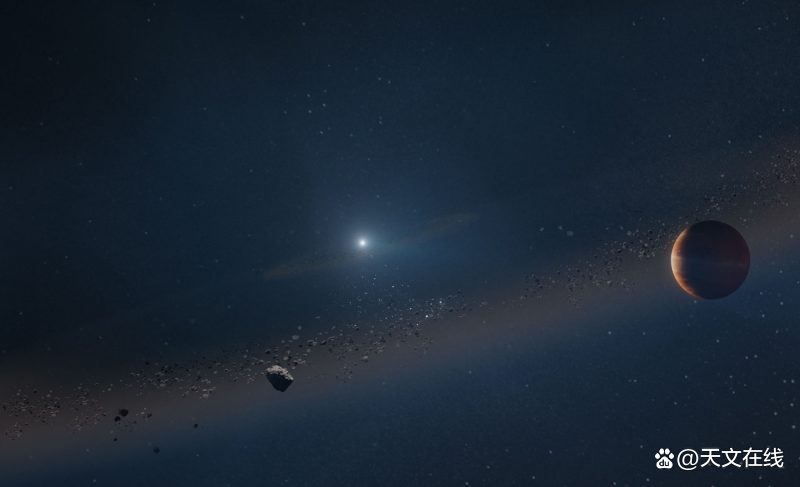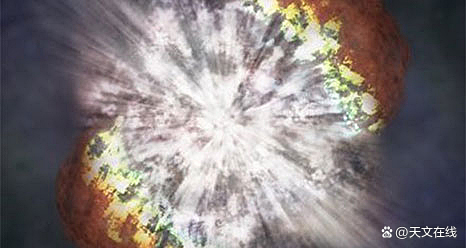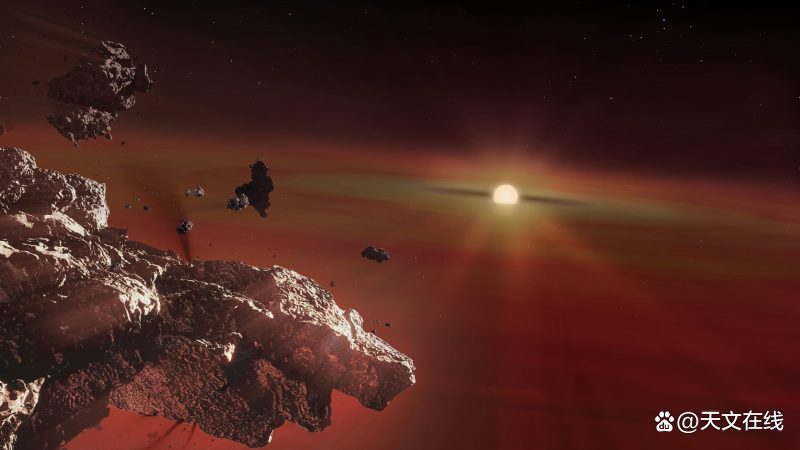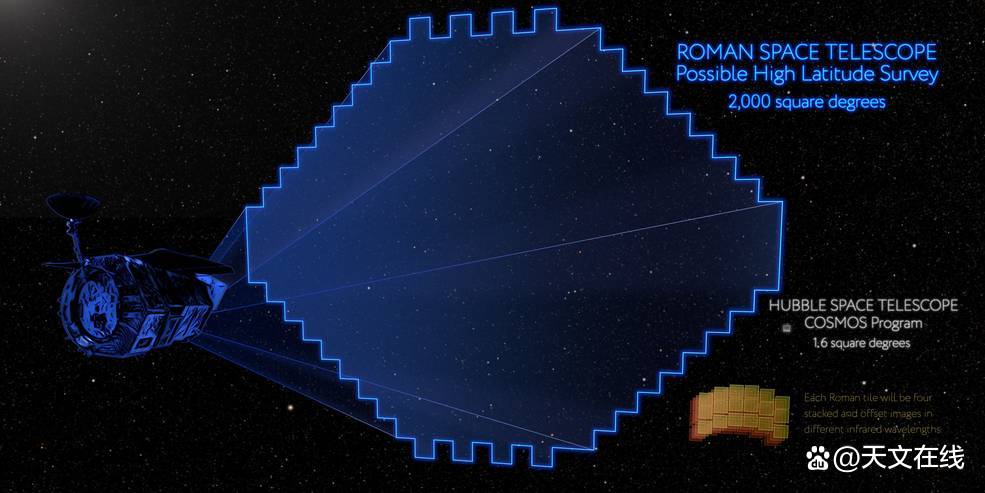What will happen to the solar system after the solar explosion?Where should the earth go?
Author:Astronomy online Time:2022.07.03
The future of the solar system: the first planet around the white dwarf
The future of the solar system: The center is a dim white light, and the huge sphere and irregular rock surround the center are operating in the most significant position.

(Illustration: The concept of the artist shows many fragments and a giant giant star around a white dwarf. This is a glimpse of the future solar system. Source: W. M. KECK Observatory/Adam Makarenko))
Scientists have found evidence that some planets in the solar system can survive after the sun dies. On October 13, 2021, scientists announced that it discovered a star system facing the center of the galaxy in the center of the Milky Way, where there was a star like the sun, but it now has become a dense white dwarf. A giant starring star is still turning around this star week, and its volume is similar to the large planet Jupiter in the solar system. This proves that when the sun expands into a red superstar and enter the phase of the white dwarf evolution, (at least) Jupiter will survive. The newly discovered Jupiter -sized planet is still turning around its cooler coolant. Therefore, for the first time, we were able to see the future of the solar system 5 billion years later.

(Graphic: Supernate, a kind of explosion at the end of the stars evolution. Source: NASA)
Astronomers published their research results in the journal "Nature" on the peer review journal "Nature" on October 13.
Astronomers completed the research work in the Kake Observatory in Hawaii. The first author of the paper, Joshua Blackman from the University of Tasmania, said:
"This discovery confirms that planets that turn around the star at a distance can survive after the stars die. Given that the system is very similar to the solar system, its status quo shows , Jupiter and Saturn may be able to stay. "

(Illustration: The concept of the Red Super Star created by the artist. Before the supernova explosion during this stage. Source: W. M. KECK Observatory/ Adam Makarenko)
The future of the solar system: layman star and internal planet
Scientists have always been curious about whether foreign planets can exempt the red superstar stage in the red superstar who are swollen and stay around the stars for a long time. Evidence now shows that this is possible. But the hopes of the Earth through that stage were very slim. Scientists predict that when the sun expands to celebrities, it will devour Mercury, Venus and even the earth. Therefore, in order to survive, humans need to arrange the evacuation plan. David Bennett, a thesis co -author from the University of Maryland and NASA Goddad Space Flying Center, said:
"The earth is much closer to the sun, and it may not be optimistic in the future. Suppose humans want to move to a satellite that moved to Jupiter or Saturn before the sun enters the red super -superstar stage and bombed the earth, we will stay on the orbit of the daily orbit. Although the sun will become a white dwarf at that time, we may not rely on the sun thermal energy for a long time. "

(Illustration: The concept map of the artist's evaporation around the white dwarf is evaporated around the white dwarf.
Discover white dwarfs and its planets
The sun is the main stars. The main stars are ordinary stars. As their age increases, their hydrogen is constantly burning and gradually expands into red superstars. The sun in the red superstar stage may swallow the earth, depending on how much the sun collapses inward and expands beyond its outer layer. Subsequently, the remaining part of the solar explosion became a cool white dwarf. The white dwarf is essentially a star of death.
The volume of white dwarfs is equivalent to the earth, but the quality is half of the sun. Due to the small size and low temperature, the white dwarf is dim. The Kike telescope capture through high -resolution near infrared imaging, and discovered this pair of dwarf stars and its planets by gravitational microscope effects. The gravitational microscope effect refers to the phenomenon that the stars in the near distant stars are aligned with the distant stars.

(Drawing: Left: Fighting view of the lens system. From the light source (top), the light emitted along the carrier of the lens gravitational field deflection to the bottom of the observer. From the perspective of the observer, the obvious position of the light source is in the direction of the dotted arrow. Above, farther than the real light source from the lens. Right: The lens system is in the sky, assuming the lens is symmetrical around the cylindrical. Each point of the light source moves outward. The source image distortion observed in the case.
Scientists noticed that the light emitted by the stars enlarged by the "lens" was distorted. It was this that led people to discover the outer planet. Its white dwarf weighs about 60%of the sun, and its own weight is about 40%larger than Jupiter. Due to its dimness, scientists believe that its light cannot come from the main stars or brown dwarfs. Jean-Philippe Beaulieu, the essay of thesis from the University of Tasmania, explained:
"We have also ruled out that it is the possibility of neutron or black holes. This means that this planet is bypassing a dead star, that is, white dwarfs. It presents the scene where the earth disappears after the disaster of the sun, and the solar system may produce."

(Illustration: The Kepler-186F concept map created by the artist. Kepler-186F is the first earth-sized rock planet found in its star livable belt. In the white dwarf star, the planet evaporates similar to the earth and Mars ingredients in the white dwarf. Further shows that such a system is very common in the Milky Way.
Scientists will use these new data to explore how many planets are surrounded by such white dwarfs. The Nancy Grace Roman Telescope, which is expected to be launched in the middle of the past ten years, will be able to investigate the planet around the white dwarf week that is far from galaxy nuclear balls. John O’Meara's John O’Meara's incense platform concluded:
"This result is very exciting. Today, when the mission of the Roman telescope is the beginning, seeing the research that the Kaic Observatory may carry out in the future is really great."
(Illustration: Roman telescope will conduct high -latitude and wide -area surveys. As shown in the blue area in the figure, the survey scope is more than 1,000 times the Hubble telescope. . Source: NASA Guded Space Flying Center)

The most important information: Scientists have discovered a giant giant star around the white dwarf, thus peeping into the future of the solar system. One day the sun will expand into a red superstar, then collapsed into a white dwarf, and spent the years in the form of a white dwarf.
By: Kelly Kizer Whitt
FY: Bowl of Shengjiu Barball
If there is related content infringement, please contact the author to delete after the work is released
Reprinted, please obtain authorization, and pay attention to maintaining integrity and indicating the source
- END -
The 13th Chinese women and children's healthy development promotion summit forum was held in Han

On June 25, the 2022 Medical Frontier Forum and the 13th Chinese Maternal Maternal...
Space Station Construction: Someone in the sky is good

At 20:50 on June 5th, Chen Dong, Liu Yang, and Cai Xuzhe, Shenzhou 14, entered Tia...